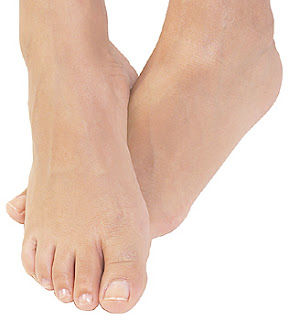Plantar Fasciitis is one of the most common foot ailments that I deal with on a regular basis. I have listened to more people describe their symptoms that when I got it I knew exactly what it was. I can tell you from experience - it is not something that you ever want to have.
WHAT IS PLANTAR FASCIITIS? Plantar Fasciitis is inflammation of the thick tissue on the bottom of the foot. This tissue is called the plantar fascia. It connects the heel bone to the toes and creates the arch of the foot and when it's inflamed it HURTS.
WHAT ARE THE SYMPTOMS? The most common complaints are PAIN and STIFFNESS in the bottom of the heel. That pain can be sharp or dull and the bottom of the foot could also burn or ache. The pain is usually worse as you try to take your first steps in the morning, after sitting or standing for a length of time, when climbing stairs or after intense activity. The pain may develop slowly over time, or suddenly after intense activity. There can also be some mild foot swelling or redness.
Plantar Fasciitis is commonly thought of as being caused by a heel spur, but research has found that this is not the case. Heel spurs are seen in people with and without plantar fasciitis.
1.....Get a new pair of shoes. Get shoes with good arch support and cushions (like SAS Walking Shoes mentioned in Chapter 9)
 |
| Picture 2 - Morning Stretch |
 |
| Picture 3 - Stretching Exercises |
3.....If my feet are really inflamed I might take an anti-inflammatory medication such as Tylenol, Advil or Motrin. You might want to check with your doctor first about this.
OTHER TREATMENTS:
1.....Resting as much as possible for a week (who can do that?).
2.....Apply ice to the painful area. Do this at least twice a day for 10-15 minutes, you may want to do it more often in the first few days.
3.....Try wearing a heel cup, felt pads in the heel area or other shoe inserts.
4.....Use night splints to stretch the fascia overnight and help it to heal faster.
IF THOSE DON'T WORK a Health Care Provider may recommend:
1.....Wearing a boot cast for up to 6 weeks (looks like a ski boot).
2.....Custom Made Shoe Inserts (orthotics)
3.....Steroid Shots or injections into the heel (Ouch).
4.....Foot surgery may be necessary.
In almost all cases Non-surgical treatments will improve the pain and help your feet heal. I have never had Plantar Fasciitis more that 3 months, but for some treatment can last from several months to several years.
I have not had Plantar Fasciitis for over 4 years now. Why you ask? It's because I replace my shoes with the best supportive shoes I can find (SAS) at the first sign of back, knee or foot pain and I continue with my stretching exercises on a daily basis.
MY ADVICE:
1.....Your feet take you everywhere you go - take care of them. Always wear proper fitting comfortable supportive shoes.














